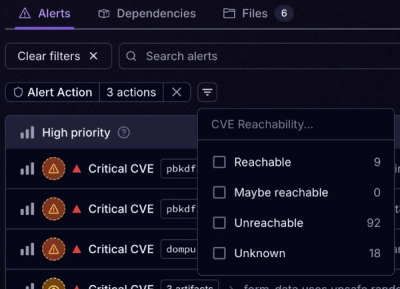
Product
Announcing Socket Fix 2.0
Socket Fix 2.0 brings targeted CVE remediation, smarter upgrade planning, and broader ecosystem support to help developers get to zero alerts.
spam-filter
Advanced tools
This spam filter lets you choose between using naive Bayes classifier or Fisher's method.
This spam filter lets you choose between using naive Bayes classifier or Fisher's method.
Data set was downloaded from http://www.dt.fee.unicamp.br/~tiago/smsspamcollection/.
It is also available on http://dcomp.sor.ufscar.br/talmeida/smsspamcollection/.
To set up the filter, all you have to do is install the module, by typing:
npm install spam-filter
Filter is initialized in a following way:
const filter = require('spam-filter')(methodName)
methodName can be 'naiveBayes', 'fisher' or empty in which case naive Bayes classifier will be used.
Naive Bayes classifier provides option to set and get thresholds for categories.
filter.setThreshold(category, 2)
filter.getThreshold(category)
Fisher's method provides option to set and get minimum values for categories.
filter.setMinimum(category, 0.7)
filter.getMinimum(category)
category is a string, default categories are 'good' and 'bad'.
Custom categories are possible, but not recommended.
Filter provides a set of methods that are available regardless of which filtering method is being used.
Those are:
filter.isSpam(spamMsg) - returns a boolean. Only works with default categories.
filter.classify(spamMsg) - returns the category, or 'none' if string can't be categorized.
filter.generate() - generates a classifier object with 5500 categorized text messages.
Generated object exists by default when module is installed.
filter.empty() - empties the classifier object.
filter.train(spamMsg, category) - trains the classifier, use category 'good' for non-spam and 'bad' for spam.
filter.save() - saves the state of the classifier object to the dataSet.js file.
Unsaved changes to the classifier object will disappear once the program that uses the filter ends.
Overriding the data set with your own:
const filter = require('spam-filter')('fisher')
const newMessages = [
['Lorem ipsum dolor sit amet, consectetur adipiscing elit.', 'good'],
['Donec faucibus vulputate feugiat.', 'bad'],
['Duis eu sapien nec elit consectetur convallis.', 'good']
]
filter.empty()
newMessages.forEach(function (newMessage) {
filter.train(newMessage[0], newMessage[1])
})
filter.setMinimum('bad', 0.65).save()
Writing a function that will train the classifier if the message can't be categorized, and then determine if it is spam:
const filter = require('spam-filter')()
function filterAndTrain(message) {
if (filter.classify(message) === 'none') {
filter.train(message, 'bad').save()
}
return filter.isSpam(message)
}
FAQs
This spam filter lets you choose between using naive Bayes classifier or Fisher's method.
We found that spam-filter demonstrated a not healthy version release cadence and project activity because the last version was released a year ago. It has 1 open source maintainer collaborating on the project.
Did you know?

Socket for GitHub automatically highlights issues in each pull request and monitors the health of all your open source dependencies. Discover the contents of your packages and block harmful activity before you install or update your dependencies.

Product
Socket Fix 2.0 brings targeted CVE remediation, smarter upgrade planning, and broader ecosystem support to help developers get to zero alerts.

Security News
Socket CEO Feross Aboukhadijeh joins Risky Business Weekly to unpack recent npm phishing attacks, their limited impact, and the risks if attackers get smarter.

Product
Socket’s new Tier 1 Reachability filters out up to 80% of irrelevant CVEs, so security teams can focus on the vulnerabilities that matter.